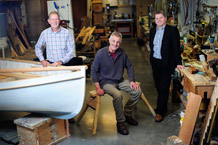
Left to right: Andy Wyke (National Maritime Museum), Brian Cumby (boat builder) and Professor Robert Van de Noort (University of Exeter) pictured at the National Maritime Museum Cornwall. Photo by Jim Wileman.
Unlocking Cornwall's Bronze Age past
A modern day boat builder is being challenged to recreate the oldest boat ever found in western Europe, dating to around 2000 BC.
The prehistoric boat will be built to scale using ancient tools such as bronze axes at the National Maritime Museum Cornwall in Falmouth, as part of a collaborative project devised by the University of Exeter.
Professor Robert Van de Noort of the University of Exeter is one of the world’s leading experts in Bronze Age period sewn-plank boats. He is leading the Arts and Humanities Research Council funded project that will produce the exhibition 2012BC: Cornwall and the Sea in the Bronze Age at the National Maritime Museum Cornwall. Archaeologists and engineers at the University of Southampton and Oxford Brookes University are also involved in developing the interactive project with experts at the University of Exeter.
The Bronze Age sewn-plank boats are unique to England and Wales. The longest were 16 metres in length and made of oak. The hull of the boat was made by stitching wooden planks together; this sewing technique was used as nails had yet to be invented. This way of building boats still exists in remote areas of Norway, Finland and some parts of India, although on different types of boats and with the use of modern tools. The boats are now commonly referred to as sewn-plank boats.
Brian Cumby is a shipwright (professional boat builder) and will oversee the building of the prehistoric boat in an open workshop at the Museum. This will enable the public to see the development of the boat over a five-month period, starting in April. Prior to this, Brian will be immersed in the world of Bronze Age Britain with Professor Van de Noort and colleagues at the Universities of Exeter and Southampton. He will learn about the tools available to Bronze Age boat builders, and will start to experiment and learn how to split logs and make planks using bronze axes and adzes rather than a modern day saw. He will also experiment with the use of the fibres from the branches of the yew tree, which were used to stitch the planks together, and with the use of moss as caulking, to stop the boat from leaking.
The live reconstruction of the prehistoric boat is being built to find out more about the process behind building a sewn boat, to examine the seaworthiness of such vessels and to understand how it was built and sailed.
Professor Robert Van de Noort of Archaeology the University of Exeter explained: “Because none of the boats have ever been found as complete boats this project will seek to understand how they were constructed, how to steer such a long boat, measure how fast it can go, understand how the crew used paddles, as sails were not evident, and how watertight it is.”
The National Maritime Museum Cornwall is joining forces with the University of Exeter to enable members of the public and especially people interested in sailing or boat building to get directly involved in the construction of the Bronze Age boat. Andy Wyke, Boat Collections Manager at National Maritime Museum Cornwall said: “This is a really exciting, ambitious, challenging and unique. We are honoured to be hosting this ‘never been done before’ project, to be working with University of Exeter and looking forward together, to unlocking Cornwall’s prehistoric maritime heritage and its connections to Europe.
"This is a first for us. As soon as the exhibition opens, the ‘live’ nature of the build will deliver new insights daily. Inviting the public to get ‘hands-on’ with the build is a new way of thinking and offers a wonderful transfer of skills and knowledge. Building on our research capacity in such a way allows us a new opportunity to expand our knowledge as a maritime research centre.”
2012BC Cornwall and the Sea in the Bronze Age opens, accompanied by rare objects never before seen in the UK, at National Maritime Museum Cornwall on 13 April and runs until 30 September.
Date: 13 January 2012
